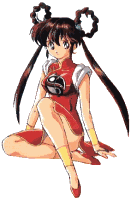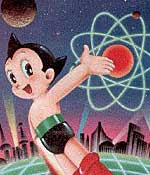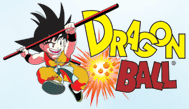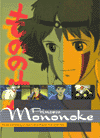
 pornography.
pornography.
"Anime" also refers to films in this style.
The term is borrowed from the
French word for animation, and suggests the roots of the form,
in a blending of the Japanese pictorial
tradition represented by
silk painting and woodblock prints,
with American-style character
design and genre stories. Among
the constants in this form is the look of the characters, which,
while allowing for some minor variations from artist to artist, generally insists on simple
lines, shapes,
and stylized features
-- idealized bodies topped
by huge, heart-shaped faces,
themselves dominated by large, round, glossy
eyes, with hair in shades of blond, red, and blue. Strikingly,
this is a look that can appear to be un-Japanese. Its not
so simple.
Osamu Tezuka
(Japanese, 1928-1989) is generally given credit for devising the
style. A great admirer of the work of Americans Walt Disney and
Max Fleisher, Tezuka created his first widely popular character,
Astro Boy, in a 1951 comic book. Astro Boy was a space-age Pinocchio-like
creation. Tezuka turned Astro Boy into an animated TV series in
1963. (Astro Boy © Tezuka Productions.)
Typical of anime ever  since are
the kind of jerky, discontinuous movements
characteristic of the earliest works in the style. Most anime
have been designed to fit the low budgets typical of television
production, employing fewer cels
per second than traditionally
produced for big-screen films. Even when working on projects with
larger budgets and for theatrical release, makers of
since are
the kind of jerky, discontinuous movements
characteristic of the earliest works in the style. Most anime
have been designed to fit the low budgets typical of television
production, employing fewer cels
per second than traditionally
produced for big-screen films. Even when working on projects with
larger budgets and for theatrical release, makers of  anime avoid
the use of computer equipment or additional cels per second that
would allow for more smooth, fluid animation. Reasons for a Japanese
preference for this jagged quality
of motion are likely to include the Japanese passion for manga,
the massive comic books published in Japan. Manga, like anime,
uses startling compositions
to segue from one panel to the next. Japanese 19th century woodblock prints called ukiyo-e,
typically conveyed a sense of movement with a dynamism now often seen
in anime, in expressive,
though static gestures, and in expressive flourishes of moody
colors. There are works ranging
from the highly disposable series of kids' TV productions of the
last decade, like Sailor Moon, Pokémon, Digimon,
anime avoid
the use of computer equipment or additional cels per second that
would allow for more smooth, fluid animation. Reasons for a Japanese
preference for this jagged quality
of motion are likely to include the Japanese passion for manga,
the massive comic books published in Japan. Manga, like anime,
uses startling compositions
to segue from one panel to the next. Japanese 19th century woodblock prints called ukiyo-e,
typically conveyed a sense of movement with a dynamism now often seen
in anime, in expressive,
though static gestures, and in expressive flourishes of moody
colors. There are works ranging
from the highly disposable series of kids' TV productions of the
last decade, like Sailor Moon, Pokémon, Digimon,
(pr. AH-nee-may)
The author wishes to thank Reid Pierre Delahunt for his assistance with this article.
Also see proportion.
https://inform.quest/_art
Copyright © 1996-![]()